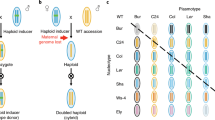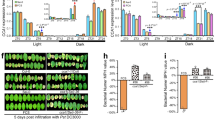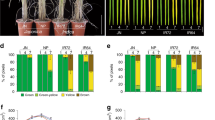Abstract
Segregating hybrids and stable allopolyploids display morphological vigour1,2,3, and Arabidopsis allotetraploids are larger than the parents Arabidopsis thaliana and Arabidopsis arenosa1,4—the mechanisms for this are unknown. Circadian clocks mediate metabolic pathways and increase fitness in animals and plants5,6,7,8. Here we report that epigenetic modifications of the circadian clock genes CIRCADIAN CLOCK ASSOCIATED 1 (CCA1) and LATE ELONGATED HYPOCOTYL (LHY)9,10,11 and their reciprocal regulators TIMING OF CAB EXPRESSION 1 (TOC1) and GIGANTEA (GI)10,12,13 mediate expression changes in downstream genes and pathways. During the day, epigenetic repression of CCA1 and LHY induced the expression of TOC1, GI and downstream genes containing evening elements14 in chlorophyll and starch metabolic pathways in allotetraploids and F1 hybrids, which produced more chlorophyll and starch than the parents in the same environment. Mutations in cca1 and cca1 lhy and the daily repression of cca1 by RNA interference (RNAi) in TOC1::cca1(RNAi) transgenic plants increased the expression of downstream genes and increased chlorophyll and starch content, whereas constitutively expressing CCA1 or ectopically expressing TOC1::CCA1 had the opposite effect. The causal effects of CCA1 on output traits suggest that hybrids and allopolyploids gain advantages from the control of circadian-mediated physiological and metabolic pathways, leading to growth vigour and increased biomass.
This is a preview of subscription content, access via your institution
Access options
Subscribe to this journal
Receive 51 print issues and online access
$199.00 per year
only $3.90 per issue
Buy this article
- Purchase on Springer Link
- Instant access to full article PDF
Prices may be subject to local taxes which are calculated during checkout




Similar content being viewed by others
References
Wang, J. et al. Genomewide nonadditive gene regulation in Arabidopsis allotetraploids. Genetics 172, 507–517 (2006)
Lippman, Z. B. & Zamir, D. Heterosis: revisiting the magic. Trends Genet. 23, 60–66 (2007)
Birchler, J. A., Auger, D. L. & Riddle, N. C. In search of the molecular basis of heterosis. Plant Cell 15, 2236–2239 (2003)
Comai, L. et al. Phenotypic instability and rapid gene silencing in newly formed Arabidopsis allotetraploids. Plant Cell 12, 1551–1568 (2000)
Dodd, A. N. et al. Plant circadian clocks increase photosynthesis, growth, survival, and competitive advantage. Science 309, 630–633 (2005)
Wijnen, H. & Young, M. W. Interplay of circadian clocks and metabolic rhythms. Annu. Rev. Genet. 40, 409–448 (2006)
Panda, S., Hogenesch, J. B. & Kay, S. A. Circadian rhythms from flies to human. Nature 417, 329–335 (2002)
Michael, T. P. et al. Enhanced fitness conferred by naturally occurring variation in the circadian clock. Science 302, 1049–1053 (2003)
Mizoguchi, T. et al. LHY and CCA1 are partially redundant genes required to maintain circadian rhythms in Arabidopsis . Dev. Cell 2, 629–641 (2002)
Alabadi, D. et al. Reciprocal regulation between TOC1 and LHY/CCA1 within the Arabidopsis circadian clock. Science 293, 880–883 (2001)
Wang, Z. Y. & Tobin, E. M. Constitutive expression of the CIRCADIAN CLOCK ASSOCIATED 1 (CCA1) gene disrupts circadian rhythms and suppresses its own expression. Cell 93, 1207–1217 (1998)
Strayer, C. et al. Cloning of the Arabidopsis clock gene TOC1, an autoregulatory response regulator homolog. Science 289, 768–771 (2000)
Park, D. H. et al. Control of circadian rhythms and photoperiodic flowering by the Arabidopsis GIGANTEA gene. Science 285, 1579–1582 (1999)
Harmer, S. L. et al. Orchestrated transcription of key pathways in Arabidopsis by the circadian clock. Science 290, 2110–2113 (2000)
Leitch, A. R. & Leitch, I. J. Genomic plasticity and the diversity of polyploid plants. Science 320, 481–483 (2008)
Chen, Z. J. Genetic and epigenetic mechanisms for gene expression and phenotypic variation in plant polyploids. Annu. Rev. Plant Biol. 58, 377–406 (2007)
Rieseberg, L. H. & Willis, J. H. Plant speciation. Science 317, 910–914 (2007)
Wang, J., Tian, L., Lee, H. S. & Chen, Z. J. Nonadditive regulation of FRI and FLC loci mediates flowering-time variation in Arabidopsis allopolyploids. Genetics 173, 965–974 (2006)
Alabadi, D., Yanovsky, M. J., Mas, P., Harmer, S. L. & Kay, S. A. Critical role for CCA1 and LHY in maintaining circadian rhythmicity in Arabidopsis. . Curr. Biol. 12, 757–761 (2002)
McClung, C. R. Plant circadian rhythms. Plant Cell 18, 792–803 (2006)
Jenuwein, T. & Allis, C. D. Translating the histone code. Science 293, 1074–1080 (2001)
Doyle, M. R. et al. The ELF4 gene controls circadian rhythms and flowering time in Arabidopsis thaliana. Nature 419, 74–77 (2002)
Reinbothe, S., Reinbothe, C., Lebedev, N. & Apel, K. PORA and PORB, two light-dependent protochlorophyllide-reducing enzymes of angiosperm chlorophyll biosynthesis. Plant Cell 8, 763–769 (1996)
Sperling, U., van Cleve, B., Frick, G., Apel, K. & Armstrong, G. A. Overexpression of light-dependent PORA or PORB in plants depleted of endogenous POR by far-red light enhances seedling survival in white light and protects against photooxidative damage. Plant J. 12, 649–658 (1997)
Lloyd, J. R., Kossmann, J. & Ritte, G. Leaf starch degradation comes out of the shadows. Trends Plant Sci. 10, 130–137 (2005)
Smith, A. M., Zeeman, S. C. & Smith, S. M. Starch degradation. Annu. Rev. Plant Biol. 56, 73–98 (2005)
Smith, S. M. et al. Diurnal changes in the transcriptome encoding enzymes of starch metabolism provide evidence for both transcriptional and posttranscriptional regulation of starch metabolism in Arabidopsis leaves. Plant Physiol. 136, 2687–2699 (2004)
Eimert, K., Wang, S. M., Lue, W. I. & Chen, J. Monogenic recessive mutations causing both late floral initiation and excess starch accumulation in Arabidopsis . Plant Cell 7, 1703–1712 (1995)
Hall, A. et al. The TIME FOR COFFEE gene maintains the amplitude and timing of Arabidopsis circadian clocks. Plant Cell 15, 2719–2729 (2003)
Perales, M. & Mas, P. A functional link between rhythmic changes in chromatin structure and the Arabidopsis biological clock. Plant Cell 19, 2111–2123 (2007)
Madlung, A. et al. Remodeling of DNA methylation and phenotypic and transcriptional changes in synthetic Arabidopsis allotetraploids. Plant Physiol. 129, 733–746 (2002)
Wang, J. et al. Stochastic and epigenetic changes of gene expression in Arabidopsis polyploids. Genetics 167, 1961–1973 (2004)
Clough, S. J. & Bent, A. F. Floral dip: a simlified method for Agrobacterium-mediated transformation of Arabidopsis thaliana . Plant J. 16, 735–743 (1998)
Lee, H. S. et al. Sensitivity of 70-mer oligonucleotides and cDNAs for microarray analysis of gene expression in Arabidopsis and its related species. Plant Biotechnol. J. 2, 45–57 (2004)
Mochizuki, N., Brusslan, J. A., Larkin, R., Nagatani, A. & Chory, J. Arabidopsis genomes uncoupled 5 (GUN5) mutant reveals the involvement of Mg-chelatase H subunit in plastid-to-nucleus signal transduction. Proc. Natl Acad. Sci. USA 98, 2053–2058 (2001)
Yu, T. S. et al. The Arabidopsis sex1 mutant is defective in the R1 protein, a general regulator of starch degradation in plants, and not in the chloroplast hexose transporter. Plant Cell 13, 1907–1918 (2001)
Smith, A. M. & Zeeman, S. C. Quantification of starch in plant tissues. Nature Protocols 1, 1342–1345 (2006)
Focks, N. & Benning, C. wrinkled1: A novel, low-seed-oil mutant of Arabidopsis with a deficiency in the seed-specific regulation of carbohydrate metabolism. Plant Physiol. 118, 91–101 (1998)
Harmer, S. L. & Kay, S. A. Positive and negative factors confer phase-specific circadian regulation of transcription in Arabidopsis . Plant Cell 17, 1926–1940 (2005)
The Arabidopsis Genome Initiative. Analysis of the genome sequence of the flowering plant Arabidopsis thaliana . Nature 408, 796–815 (2000)
Bastow, R. et al. Vernalization requires epigenetic silencing of FLC by histone methylation. Nature 427, 164–167 (2004)
Tian, L. et al. Reversible histone acetylation and deacetylation mediate genome-wide, promoter-dependent and locus-specific changes in gene expression during plant development. Genetics 169, 337–345 (2005)
Acknowledgements
We are grateful to E. Tobin for her gifts of the CCA1-overexpression (CCA1-OX) line and antibodies against CCA1. We thank H. Y. Chen for advice on recombinant CCA1 production, D. W. Ng for western blot analysis, T. Juenger for insightful discussions on life history traits in Arabidopsis, and D. Y. Chen and E. Huq for careful readings of the manuscript. The work was supported by the grants from the National Science Foundation Plant Genome Research Program (DBI0733857 and DBI0624077) and the National Institutes of Health (GM067015; Z.J.C.) and National Basic Research Program of China (2007CB109000; Q.S.).
Author Contributions Z.N. examined gene expression, ChIP, chlorophyll, starch and sugars in allotetraploids and hybrids. E.-D.K. analysed CCA1 mRNA, protein, chlorophyll and starch in the transgenic plants and mutants. M.H. conducted statistical tests. E.L. performed EMSA. J.L. assayed western blots and ChIP. Y.Z. assisted cloning. Q.S. discussed the experiments. Z.J.C. conceived the project, analysed the data and wrote the paper.
Author information
Authors and Affiliations
Corresponding author
Supplementary information
Supplementary Information
This file contains Supplementary Tables 2-6 and Supplementary Figures 1-6 with Legends. (PDF 8062 kb)
Supplementary Table 1
This file contains Supplementary Table 1. (XLS 42 kb)
Rights and permissions
About this article
Cite this article
Ni, Z., Kim, ED., Ha, M. et al. Altered circadian rhythms regulate growth vigour in hybrids and allopolyploids. Nature 457, 327–331 (2009). https://doi.org/10.1038/nature07523
Received:
Accepted:
Published:
Issue Date:
DOI: https://doi.org/10.1038/nature07523
This article is cited by
-
Dynamic patterns of gene expression and regulatory variation in the maize seed coat
BMC Plant Biology (2023)
-
Physiological and biochemical responses to short-term cold stimulation of pak choi under heat stress
Plant Growth Regulation (2023)
-
Transcriptome profiling of two super hybrid rice provides insights into the genetic basis of heterosis
BMC Plant Biology (2022)
-
Genome-edited powdery mildew resistance in wheat without growth penalties
Nature (2022)
-
Environment-mediated mutagenetic interference on genetic stabilization and circadian rhythm in plants
Cellular and Molecular Life Sciences (2022)
Comments
By submitting a comment you agree to abide by our Terms and Community Guidelines. If you find something abusive or that does not comply with our terms or guidelines please flag it as inappropriate.



